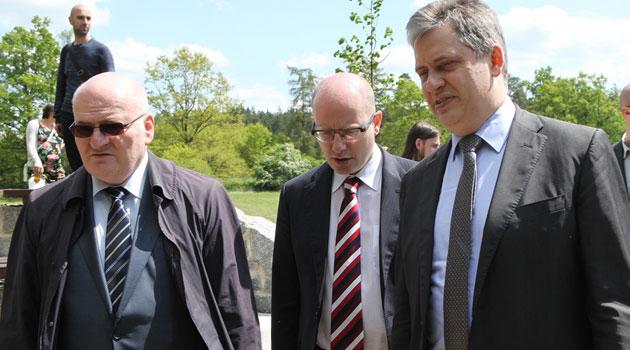Czech Human Rights Minister: A pig farm on a site of human suffering disrespects both survivors and victims

Czech Human Rights Minister Jiří Dienstbier has indicated that he would like to attempt to remove the pig farm in Lety by Písek from the site of a former WWII-era camp for Romani people there. "Given that there was a concentration camp in Lety where many people suffered, the fact that a pig farm is on that site disrespects both the survivors and the victims," he told news server iDNES.cz.
"I would be glad if this could manage to be resolved, if the site could serve purely the purposes of commemoration, not agricultural production, but I understand it may be complicated to achieve a solution since the operations there are in private hands," Dienstbier said. The minister did not want comment in detail on how the problem might be solved, but stated that it would involve expenditure from the state budget.
The reason the minister is not openly saying the Government might attempt to buy the pig farm is that to do so would immediately raise the price. "Without reaching an agreement with the private owner of the buildings and land it’s not possible to move forward with this matter. Negotiations could be either very quick or take a very long time," he told iDNES.cz.
It is not clear whether currently the other members of the Government will agree with the pig farm’s removal by the state. In May 2014, Czech Prime Minister Bohuslav Sobotka said he would prefer to invest the money it would take to buy the pig farm into something else.
In October 2013, however, during a campaign debate, all of the representatives of the parties in the current governing coalition expressed agreement with the pig farm being removed. When asked whether, if they were elected to the lower house, they would support finally buying and demolishing the pig farm at Lety and erecting a Romani Holocaust Memorial there using public money, all of the participating candidates said they would.
"Yes… if the price is humane, not usurious, and if private organizations will also participate in building the memorial. I think we can manage to raise the money from private sponsors," Martin Komárek of the ANO movement said just before the elections in 2013.
Jan Bartošek of the Christian Democrats (KDU-ČSL) also mentioned the basic historical context with respect to the operation of the concentration camp for Romani people at Lety. "What is essential is one thing, that in Lety the concentration camp was not run by Germans, but by Czechs. That means our nation bears, in some way, co-responsibility for what happened there," he emphasized.
The history of the concentration camp at Lety
The original space at Lety served in 1940 as an accommodation facility for construction workers. Subsequently, a disciplinary labor camp was created there on the orders of the Interior Minister of the Protectorate Government, Josef Ježek, on 15 July 1940, issued on the basis of Government Decree No. 72 on disciplinary labor camps dated 2 March 1939.
That particular decree had been issued prior to the country being occupied by the Nazis. According to the decree, "wandering gypsies and other vagrants living in the same way who are capable of work, beggars by trade and those who make a living from begging (children, etc.), gamblers by trade, inveterate idlers, loafers and persons making a living from dishonest earnings (prostitution, etc.), whether their own or those of others" were to be rounded up and concentrated in particular facilities.
The first 12 prisoners arrived at Lety on 17 July 1940. On 1 August the camp was changed into a "Gypsy camp" and subsequently entire Romani families were transported there.
The concentration camp began running on 1 August 1942 and was closed on 4 May 1943. Its capacity was increased to accommodate up to 600 prisoners, but that number was soon exceeded, as during the course of August 1942 more than 1 100 children, men and women were interned in the camp.
The camp was not equipped with the necessary hygienic or other facilities for such a large number of people. The prisoners often had to bathe in a nearby fishpond.
Until August 1942, only men were imprisoned at Lety. After that, children and women were also brought there to rot in completely unsatisfactory conditions.
After the big influx of August 1942, whole families were mostly brought to the camp as well as individuals. A total of 326 people died directly in the Lety camp, 241 of them children.
A temporary burial ground near the camp was used to inter 120 victims. Another 540 prisoners from Lety perished while being transported to Auschwitz.
A total of two mass transports were undertaken. The first one departed on 3 December 1942 as a transport of so-called asocials, 16 men and 78 women, to the Auschwitz I concentration camp.
The second transport practically meant the liquidation of the Lety camp, as it included 417 prisoners who went to the Auschwitz II-Birkenau concentration camp. While the first transport took place on the basis of a decree about crime prevention, the second took place on the basis of Himmler’s decree of 16 December 1942, which ordered the transport of all Romani people to the Auschwitz concentration camp.
The remaining 198 prisoners were then relocated to the "gypsy camp" at Hodonín near Kunštát (the so-called Žalov camp) or were interned in camps in Pardubice and Prague. On 13 May 1995, at the site of the mass grave next to the former camp, a memorial was unveiled with the inscription "To the victims of the gypsy camp at Lety 1942-1943. Never forget. Ma bisteren."
On 13 May 2010 the Lety Memorial was officially opened there. A government decision has entrusted the Lidice Memorial with its management.